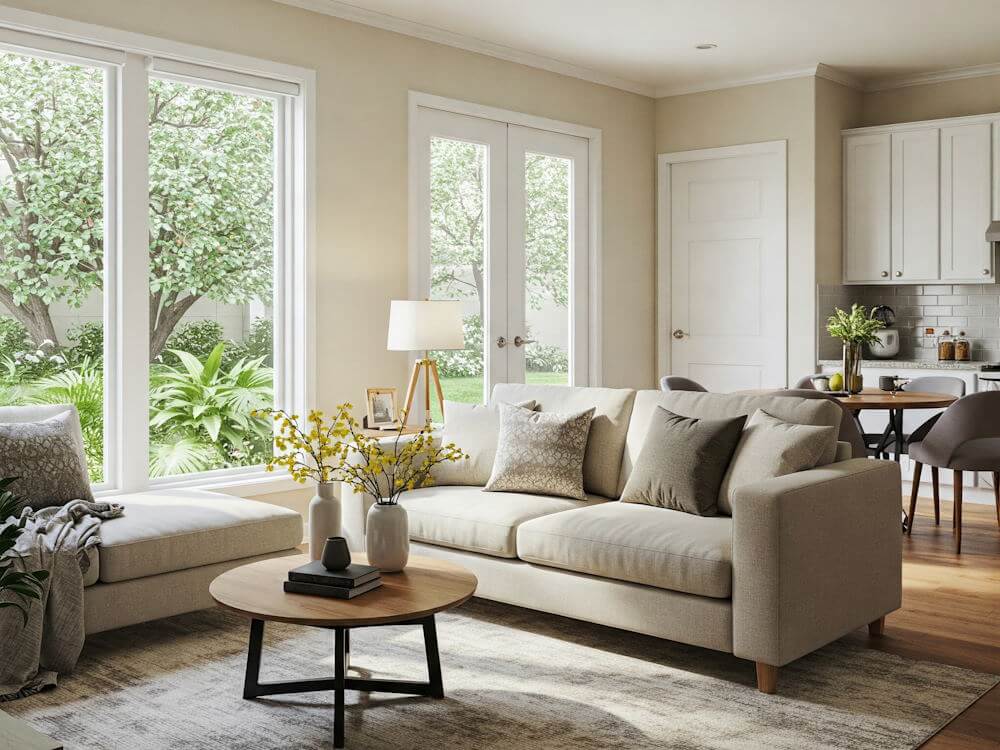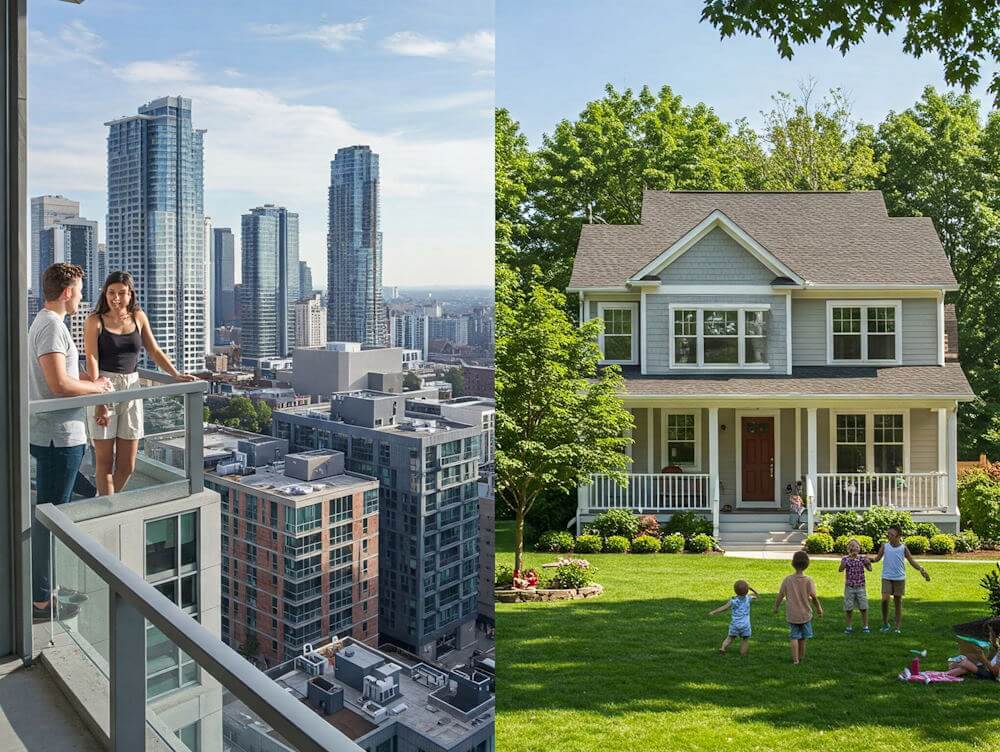Introduction to Home Staging
Home staging is an essential process in the real estate market, aimed at preparing a property for sale to maximize its appeal to potential buyers. This practice involves strategically arranging furniture, decor, and other elements to highlight a home’s best features, creating an inviting atmosphere that resonates with prospective inhabitants. The essence of home staging lies in its ability to make a property feel like a home, rather than just a house, thereby facilitating a quicker sale and potentially increasing the sale price.
Research has consistently shown that well-staged homes are more attractive to buyers. According to a survey conducted by the National Association of Realtors, 77% of real estate agents reported that home staging made it easier for clients to visualize the property as a place to live. Staged homes not only appeal to emotions but also evoke a sense of potential within the space, allowing buyers to envision their own lives unfolding there. In fact, properties that have been staged often sell 73% faster than their non-staged counterparts, illustrating the effectiveness of this strategy.
Home staging also emphasizes important aspects such as lighting, space utilization, and cleanliness, which can significantly enhance a homeowner’s selling prospects. By decluttering and depersonalizing the space, sellers create a blank canvas for buyers to project their own identities onto, thereby allowing them to form a stronger connection to the property. Furthermore, the investment in professional staging services can yield a substantial return, often recouping up to 20% more than the original cost of staging.
In essence, home staging serves as a vital tool in the competitive real estate landscape, helping sellers stand out amidst a saturated market. A well-staged home not only captivates buyers but also fosters a quicker and more profitable sale, establishing its importance in the overall selling strategy.
The Psychology Behind Home Staging
Home staging is not merely a strategy for enhancing aesthetic appeal; it also taps into the psychological inclinations of potential buyers. When prospective homeowners enter a well-staged home, they immediately experience an emotional connection that influences their perception of the space. This connection is essential because research indicates that buyers often make decisions based on feelings rather than logic. Therefore, a staged home can facilitate a buyer’s ability to envision their life unfolding within the rooms, ultimately leading to a quicker sale.
Color psychology plays a pivotal role in staging a home effectively. Neutral colors are often favored as they evoke tranquility and openness, making it easier for buyers to imagine their own furnishings within the space. Softer hues and neutral palettes help minimize distractions, allowing the potential buyers to focus on the home’s inherent qualities. By creating a calming atmosphere, these colors can significantly enhance a potential buyer’s emotional response, making them more likely to proceed with an offer.
Moreover, decluttering a home is equally vital in establishing a psychological impact. A tidy, organized environment allows potential buyers to see the full potential of the space. Clutter can lead to feelings of chaos and may cause buyers to perceive the home as smaller or less desirable. Hence, removing personal items and excess accessories can facilitate a sense of spaciousness, inviting buyers to imagine themselves inhabiting the area without distraction.
Finally, the strategic arrangement of furniture can significantly affect how buyers interact with a staging environment. Effective furniture placement can guide movement through the home and highlight its best features. By creating inviting sightlines and functional spaces, the arrangement fosters comfort and tranquility, further enhancing the emotional connection a buyer may feel. With these psychological aspects in play, staging becomes a transformative process that resonates with potential buyers, leading to quicker transactions and successful sales.
Decluttering and Depersonalizing Your Space
When staging your home for a quick sale, one of the most crucial steps is to declutter and depersonalize your space. This process not only enhances the overall aesthetic appeal of your home but also enables potential buyers to envision themselves living there. Begin by sorting through your belongings and categorizing items into three groups: keep, donate, and discard. This systematic approach allows for a more structured decluttering process, while also promoting a sense of organization.
It is essential to remove personal photographs and memorabilia during this phase. Personal items can create emotional attachments that may distract buyers from seeing the home as a blank canvas. Aim to create a neutral environment that appeals to a broader audience. For instance, consider replacing family photos with generic artwork or neutral decor. This shift enables prospective buyers to visualize their own lives within the space, rather than feeling like visitors in someone else’s home.
Additionally, consider decluttering each room by removing excess furniture and decorative items. A spacious layout not only enhances the flow of the home but also gives the impression of a larger area. Limit accessories on surfaces to a minimal number—this approach presents a clean and tidy aesthetic. Remember that buyers might open closets and cupboards, so ensure these areas are also organized and devoid of overwhelming clutter.
In summary, the process of decluttering and depersonalizing your home is fundamental in staging effectively for a quick sale. By creating a neutral and inviting atmosphere, you facilitate a smoother transition for potential buyers, allowing them to imagine how they would personalize the space for themselves.
Furniture Arrangement Tips
When staging your home for a quick sale, the arrangement of furniture plays a crucial role in showcasing the property’s potential. A well-thought-out furniture layout can significantly enhance the flow of a space, highlight its best features, and create an inviting atmosphere for potential buyers. To achieve this, start by considering the purpose of each room and the way that individuals will likely move through the space.
One important aspect to bear in mind is the concept of flow. Proper furniture arrangement should facilitate easy movement from one area to another, preventing any obstructions that could lead to a cluttered or cramped feel. For example, in the living room, position sofas and chairs in a conversational arrangement, ensuring there’s sufficient space between them for comfortable navigation. Likewise, avoid placing large pieces directly in high-traffic paths, as this can disrupt the room’s natural flow.
Balance is another key principle when it comes to furniture arrangement. Strive for an even distribution of visual weight throughout the room. If you have a large sectional sofa on one side, counterbalance it with a tall bookshelf or an accent chair on the opposite side. This creates visual stability and prevents any single element from dominating the space. Additionally, consider using rugs to delineate areas within an open floor plan, as they can help define specific zones while enhancing overall harmony in the room.
Focal points should also be emphasized in your staging efforts. Identify the main features of each room, such as a fireplace or a large window, and arrange furniture to draw attention to these aspects. For instance, placing a stylish chair angled towards a fireplace or highlighting a window view with a strategically positioned sofa can effectively direct the buyer’s gaze, thereby enriching the room’s appeal. By adhering to these furniture arrangement tips, you can create an inviting and functional atmosphere that maximizes the sale potential of your home.
Choosing the Right Color Palette
The significance of color in home staging cannot be overstated. A well-thought-out color palette can create an inviting atmosphere that resonates with potential buyers, making it crucial for homeowners to choose carefully. Neutral and calming color schemes are often the best options, as they provide a blank canvas that allows buyers to envision their own style and possessions within the space. Soft shades of beige, gray, and pastels are particularly effective in living rooms, bedrooms, and hallways, as they engender a sense of tranquility and spaciousness.
In the kitchen and dining areas, colors like soft white, light blue, or pale green can evoke feelings of cleanliness and freshness. These hues are not only appealing but also encourage a welcoming environment where potential buyers can imagine themselves enjoying meals and gatherings. When staging these spaces, it is essential to harmonize the color scheme with existing cabinetry and countertops to maintain a cohesive look.
Color psychology plays a pivotal role in influencing buyer emotions and perceptions. For instance, blues and greens are associated with serenity, while yellows can bring a sense of warmth and cheer. However, it is crucial to avoid overly bold colors that may limit a buyer’s imagination. Bright or dark shades might be perceived as uninviting or overwhelming, potentially detracting from the property’s appeal. Instead, neutral tones can serve as a reassuring backdrop that attracts a wider audience.
Therefore, selecting the appropriate color palette is an essential step in the home staging process. It not only enhances the aesthetic appeal of the house but also positively impacts how prospective buyers perceive the property. By adopting a neutral color scheme that resonates with calmness and warmth, homeowners can significantly increase their chances of a swift sale.
Highlighting Key Features of Your Home
When staging your home for a quick sale, it is essential to highlight its unique features, as they can significantly influence a buyer’s first impression. Distinct elements, such as fireplaces, built-in shelving, and outdoor spaces, can enhance the appeal of your home and create a lasting impact. To effectively accentuate these selling points, consider utilizing strategic lighting, thoughtful decor, and careful staging techniques.
For instance, if your home boasts a fireplace, ensure that it becomes a focal point of the living area. You might consider arranging furniture around the fireplace to create an inviting conversation nook, further suggesting that this area is where many social gatherings could take place. Adding warm, ambient lighting can enhance this feature, providing a cozy atmosphere that potential buyers can envision themselves in.
Built-in shelving is another valuable aspect that can be highlighted when staging. Rather than leaving the shelves empty, incorporate curated decor items such as books, art, or plants. This not only showcases the functionality of these spaces but also adds personality to your home. By keeping the color palette cohesive and using items of varying heights, you can draw the eye upward, making the room feel larger and more inviting.
Outdoor spaces can also significantly sway a buyer’s decision. If your home has a patio or garden area, furnish it with attractive outdoor seating and tasteful decor to establish it as an extension of the living space. Utilize string lights or lanterns to create an inviting ambiance, encouraging buyers to see these spaces as perfect for entertaining or relaxing.
By emphasizing these unique features through careful staging, you can help potential buyers envision their life in your home, increasing the likelihood of a quick sale. Implementing these strategies can transform your home into a desirable listing in today’s competitive real estate market.
The Importance of Curb Appeal
Curb appeal plays a crucial role in the home-selling process, as it forms the first impression potential buyers will have of your property. A well-maintained exterior not only attracts interest but also sets a positive tone for the viewing experience. When buyers arrive, they will instinctively begin to evaluate the home before they even step inside. Therefore, enhancing the exterior through focused curb appeal strategies can significantly impact a quicker sale.
One key aspect of achieving effective curb appeal is landscaping. Regularly mowing the lawn, trimming bushes, and planting colorful flowers can create a vibrant and inviting atmosphere. Additionally, consider removing any weeds or debris that may distract from the overall aesthetic. The goal is to present a polished, well-kept exterior that reflects the care taken inside the home. Furthermore, maintaining the driveway, walkways, and sidewalks by keeping them clean and clear of clutter contributes to a well-groomed appearance.
Exterior cleaning should not be overlooked as it greatly enhances curb appeal. Power washing surfaces like siding, decks, and patios can remove dirt and grime, making your home look fresh and well-maintained. It is also beneficial to paint or touch up any areas that may show signs of wear, including the front door or window frames, in appealing, neutral colors that attract buyers yet remain personal enough to showcase the home’s unique character.
Incorporating decorative elements can elevate your home’s entrance, giving it a warm, welcoming ambiance. Simple additions such as door wreaths, tasteful house numbers, or an elegant outdoor light fixture can enhance visual appeal and contribute to a more inviting atmosphere. Selecting outdoor furniture that complements the home can also add charm, creating an appealing space that encourages buyers to envision themselves relaxing in the outdoor area. By meticulously enhancing curb appeal, you set the stage for a swift and effective sale.
Using Professional Help
When preparing a home for sale, enlisting the services of professional home stagers can significantly enhance its appeal to potential buyers. Home staging is an intricate process that involves arranging furniture, decor, and other elements to create a welcoming and attractive environment. Professional stagers bring a wealth of experience and design expertise, allowing them to effectively transform spaces tailored to market trends and buyer preferences.
One of the primary benefits of hiring a professional is their access to resources and networks that are often unavailable to the average homeowner. Stagers often have relationships with furniture rental companies, decorators, and vendors that can provide essential items to elevate a property’s presentation. Additionally, their trained eye can identify and rectify potential issues that may deter buyers, such as clutter or poor layout, thereby increasing the home’s marketability.
Finding a reputable home stager involves conducting thorough research. Prospective sellers can start by seeking recommendations from local real estate agents who are familiar with the staging process and have established connections with professionals in the field. Online platforms and reviews also serve as valuable tools for assessing the reputation and quality of potential stagers. When interviewing candidates, it is crucial to inquire about their previous work, staging strategies, and costs involved. Typical fees for home staging may vary based on factors such as the size of the property and the extent of services provided.
In regards to costs, sellers should anticipate an investment ranging from a few hundred to several thousand dollars, influenced by the scope of the project and duration of staging required. By understanding the staging process and collaborating with experienced professionals, homeowners can position their property for a quicker sale at an optimal price.
Final Touches and Clean-Up
As the home staging process nears completion, attention to detail becomes paramount in ensuring that your property leaves a lasting impression on potential buyers. A meticulous cleaning regimen can significantly enhance the overall appeal of your home. Begin by addressing every corner of the space, including windows, floors, and hard-to-reach areas that may have otherwise been overlooked. A spotless home not only reflects the level of care taken but also allows prospective buyers to envision themselves living in the space.
Moreover, incorporating decorative elements such as fresh flowers can infuse life and color into your home. Consider strategically placing vibrant bouquets in areas such as the kitchen or living room, where they can draw the eye and create focal points. Fresh flowers not only enhance visual appeal but also contribute to an inviting atmosphere, making the home feel more welcoming. Similarly, choosing the right scents can play a pivotal role in the perception of your home. Certain aromas can evoke positive emotions, prompting potential buyers to feel comfortable and at ease.
One effective method is to bake cookies or a pie before showings. The delightful scent wafting through your home can evoke warmth and familiarity, often making buyers feel an emotional connection to the space. These small gestures contribute to a homely atmosphere that encourages prospective buyers to imagine their life in your property. By excelling in these final touches and cleanliness enhancements, sellers can ensure their home stands out in a competitive real estate market.
In conclusion, paying attention to the final touches and executing a thorough clean-up not only beautifies your home but also significantly strengthens its appeal to potential buyers. The combination of cleanliness, fresh flowers, and inviting scents can ultimately leave a memorable impression, facilitating a quicker sale.




